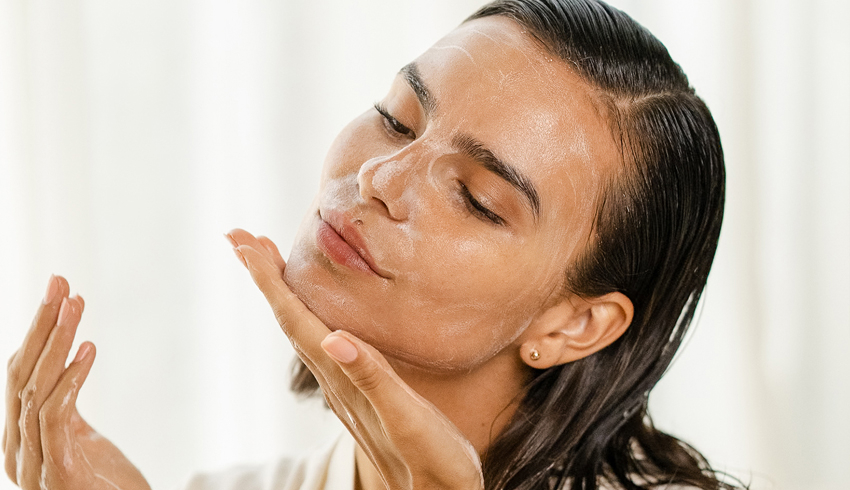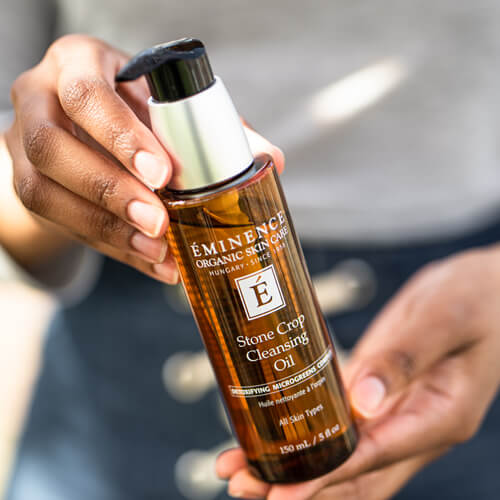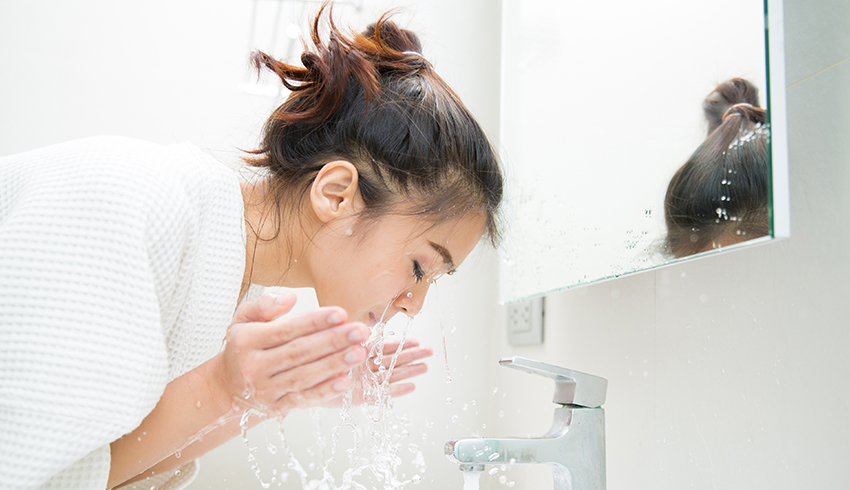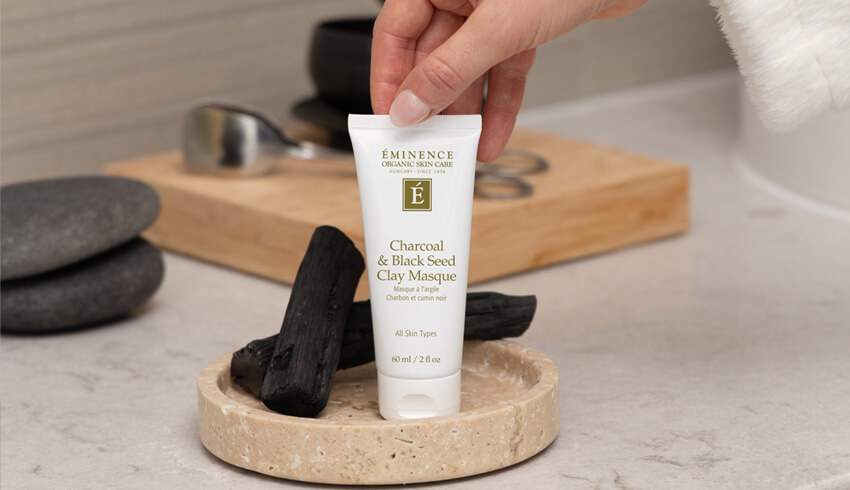
A facial cleanser should be an integral part of your daily skin care routine. Cleansers help remove dead skin cells, dirt and unwanted debris from your complexion. Clearing the skin helps us avoid breakouts caused by harmful bacteria buildup or dirt trapped in your pores. But sometimes we can get a little too passionate about our skin care routine and actually over-cleanse, causing damage to our skin barrier while overstripping moisture. So, how often should you wash your face? And which types of cleanser should you use? Read on to find out.
Benefits Of Using A Facial Cleanser
With today’s long-wearing makeup and exposure to environmental stressors and pollution, it’s necessary to take the time to fully cleanse your skin at the end of the day. In addition to removing makeup and impurities, cleansing also helps prepare your skin to better absorb the active ingredients in toners, masks, serums, moisturizers and oils. Eminence Organic Skin Care’s lineup of cleansers allows for this routine to fit for a variety of skin types. Here are some of the main benefits of facial cleansers:
Removing Build Up
Removing all the grime, oil and makeup that was built up throughout the day is essential for healthy-looking skin. The skin on your face is continually exposed to pollution, dirt, bacteria and is also subject to a buildup of skin cells. We recommend cleansing daily to target all these factors while keeping your skin clean and fresh. Failing to wash your face means your skin undergoes prolonged exposure to a layer of sweat, dirt and grime which you would then layer on other products on top of. This traps debris into your pores. If your pores are filled with oil, bacteria or dirt, then you’re far more likely to develop breakouts.
Allowing Sebum Oil To Reach The Surface
Sebum is the waxy, oily secretion produced by tiny sebaceous glands under your skin. These glands use hair follicles to let oil reach the surface of the skin, keeping your hair and skin moisturized. Sebum is crucial for keeping the skin hydrated and protected from bacteria and fungi. Regular cleansing clears away blockages and buildup, allowing the sebum to reach the surface, which reduces your chance of breaking out.
Maintaining Hydration
Cleansing helps manage pH levels of the skin, keeping skin hydrated and balanced. Particularly if you use a hydrating cleanser, your skin will maintain the proper level of hydration so that you avoid developing dry skin.

Powder Cleansers
A powder cleanser is a unique, dry formula that transforms into a luxurious, creamy lather when activated with water. The finely milled powders — often enriched with botanical enzymes and extracts — work to remove impurities, excess oil and dead skin cells, leaving your complexion soft, smooth, and radiant. Suitable for all skin types, a powder cleanser offers a customizable experience, allowing you to adjust the consistency and exfoliation level to suit your skin’s needs.
Gel Cleansers
Like the name implies, gel cleaners tend to have a gel-like consistency, designed for unclogging pores while removing excess oil and acne-causing bacteria from the surface of your skin. As a result, gel cleansers are ideal for oily skin types. Gel cleansers would be ideal for those wanting to remove excess oil and minimize the appearance of pores by keeping the skin free of gunk.
Cream Cleansers
Cleansers with a cream base deeply nourish and moisturize the skin while washing away makeup and other impurities. Cream cleansers are ideal for dry skin or sensitive skin types because they rehydrate the skin while also removing unwanted buildup from the previous day, such as dirt, sebum or makeup. Cream cleansers are a typically thicker texture and cleanse your skin without stripping it of any of its natural oils.
Foam Cleansers
These lightweight skin care products create a foamy lather when dispensed from a pump package. They remove excess oil as effectively as gel cleansers and are great for combination skin. Avoid foam cleansers if you have dry skin as the consistency will leave your skin feeling tight and dry.
Cleansing Oil
Cleansing oils provide an easy removal of all oil-based products, such as makeup and sunscreen, while also keeping your skin smooth and silky. Oils are a special type of solvent that are naturally attracted to other oils, which allows for quick dissolving of oil-based products.
Exfoliating Cleanser
An exfoliating cleanser can be in the form of a physical or chemical exfoliating cleanser. A chemical exfoliating cleanser simultaneously cleanses and gently exfoliates the skin because its formula contains a small percentage of an acid. A physical exfoliating cleanser may contain tiny granules also designed to slough off dead skin cells while providing a cleanse at the same time.
Now that you’ve decided on the best type of cleanser for you, how many times should you actually cleanse and wash your face each day?
How Often Should You Wash Your Face?
According to Healthline.com, “Every person should wash their face both morning and night.” If you can only commit to a wash once daily, do it before you go to bedtime, so you’re not putting your face on the pillow and trapping the dirt and oil deeper into the skin. Some people with dry skin don’t like cleansing twice a day as it feels too drying for their skin. If that’s the case, re-consider the type of cleanser you are using or you can simply cleanse once before bedtime.
Overcleansing (three or more times a day), or using a harsh cleanser such as a bar of soap, may weaken the skin barrier, leading to dry, dull or irritated skin. Cleansing should never lead to irritation, so if your skin is starting to feel tight and dry after washing, you may be going overboard. A healthy, functioning skin barrier means the skin looks firm and plump. The skin barrier should block environmental irritants out naturally, while keeping all the good stuff in like natural oils, and moisture.
According to the Academy Of Dermatology, here are the best tips and steps for cleansing correctly.
- Apply lukewarm water to your face. Then apply your cleanser, gently rubbing it in with your fingertips. Using a washcloth, sponge, or anything other than your fingertips can lead to irritation.
- Refrain from scrubbing with something other than a specially formulated physical exfoliant. This can cause redness and irritation.
- Rinse the cleanser off with lukewarm water and pat dry with a soft towel.
- Apply moisturizer, especially if you have dry or itchy skin.
- Limit washing to twice a day maximum, although if you have sweated profusely you can also wash your face afterwards.
- Wash your face once in the morning and once in the evening, as well as after profusely sweating.
- Follow the instructions of the cleanser. The cleanser brand will also provide how best to use their cleansers.
How many times a day do you cleanse? Check out our lineup of cleansers to see which type is for you.



